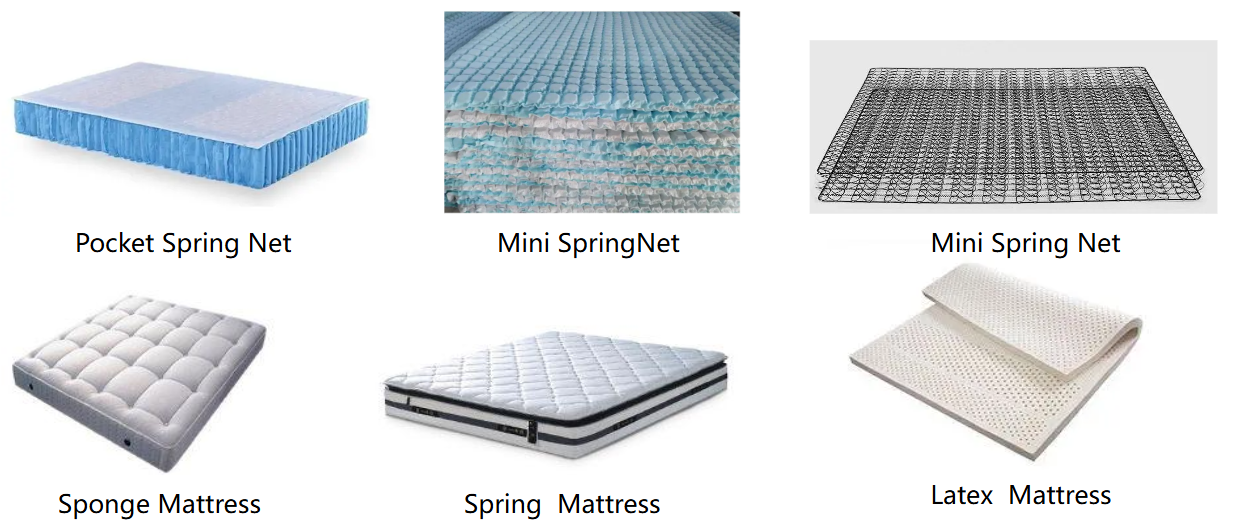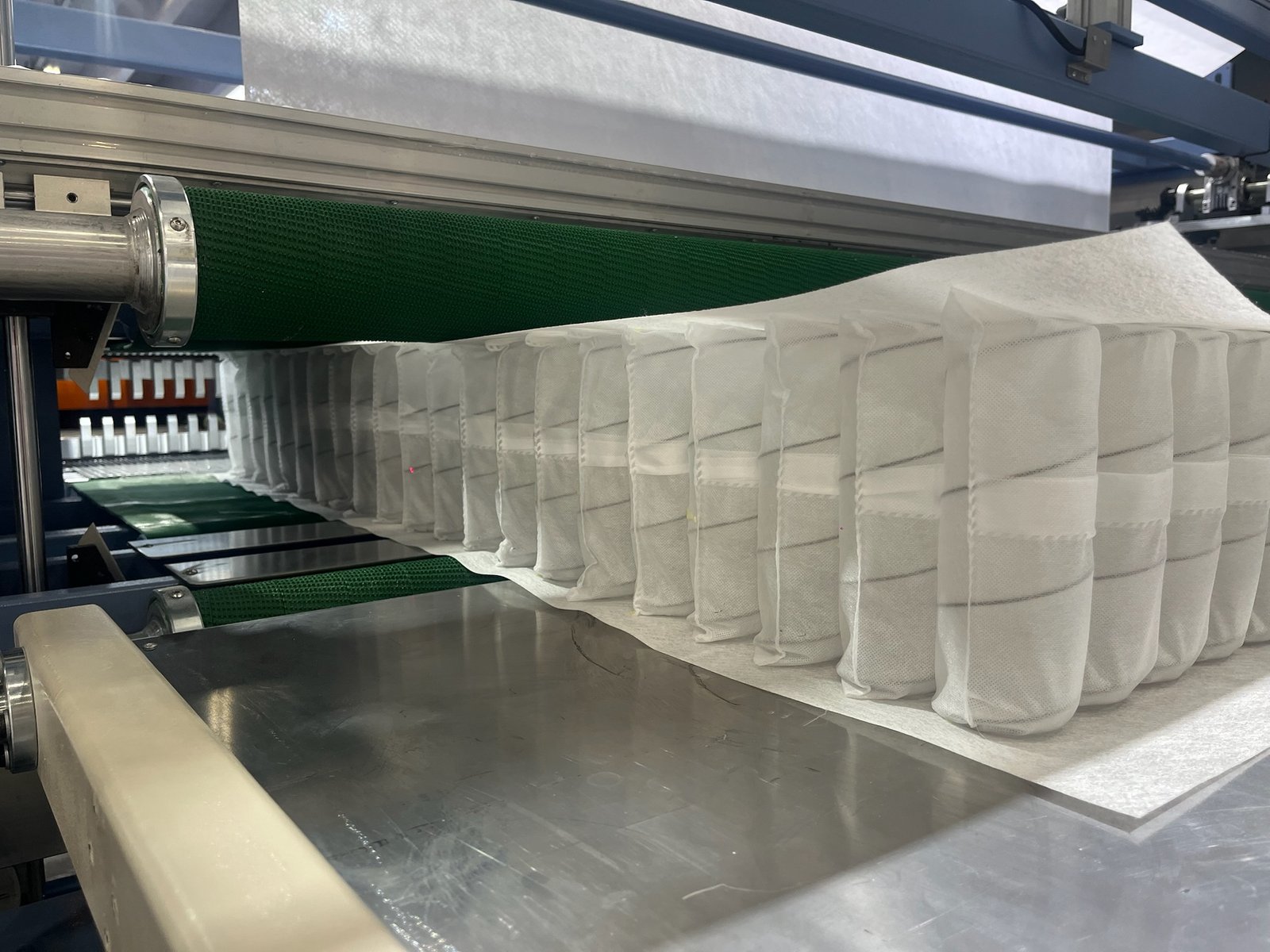What Types of Materials Can Mattress Spring Machines Process?

Springs are the core of mattress support systems—but what wire materials are used to make them?
Modern mattress spring machines can process a wide range of steel-based and coated wire materials, including high-carbon, tempered, stainless, galvanized, and copper- or plastic-coated wires. Each material serves different durability, comfort, and environmental needs.
Choosing the right wire not only affects product quality—it also influences your machine setup, maintenance, and customer satisfaction.
Let’s explore what wire types your machines can handle, and how each one plays a role in spring production.
Why Is Material Compatibility So Important?

Springs are under constant stress. The wire used to form them must:
- Withstand compression cycles without losing shape
- Provide consistent tension and rebound
- Resist rust, corrosion, or mechanical fatigue
The wrong material can lead to weak coils, early failures, or customer complaints. That’s why your machine’s ability to process various wire types—accurately and consistently—is critical for product success.
Can Mattress Spring Machines Handle High-Carbon Steel?
Yes, high-carbon steel is the most commonly processed material in mattress spring production. It provides an excellent balance of strength, elasticity, and cost-efficiency.
Why High-Carbon Steel?
| Property | Value for Mattresses |
|---|---|
| High tensile strength | Maintains spring shape over time |
| Moderate cost | Keeps production economical |
| Good fatigue resistance | Withstands repeated use |
Used in Bonnell, offset, and continuous coils, this material forms the backbone of mid-range mattresses worldwide.
Are Tempered Steel Wires Compatible?
Absolutely. Tempered steel is heat-treated for extra resilience and is common in high-performance or premium mattresses.
Tempering involves heating steel above critical temperatures and then rapidly cooling it. This increases:
- Elasticity
- Spring-back consistency
- Load-bearing strength
Machines processing tempered wire must maintain coil tension precisely to avoid cracking the hardened wire. Some high-speed CNC pocket spring machines include adaptive controls to handle this.
How About Stainless Steel?
Yes, stainless steel wire is compatible—and ideal for humid, medical, or luxury mattress applications.
It contains chromium, forming a passive layer that prevents rust and corrosion. Perfect for:
- Healthcare mattresses
- Marine-use beds
- High-humidity regions
Advantages:
| Feature | Benefit |
|---|---|
| Corrosion resistance | Prevents rust in damp conditions |
| Hypoallergenic surface | Safer for sensitive users |
| Long lifespan | Reduces replacement frequency |
Machines need tungsten-carbide guides and anti-corrosive rollers to prevent stainless wear on tooling.
Do Machines Support Galvanized Wire?
Yes. Galvanized steel is regular carbon steel coated with zinc to prevent rust.
It’s commonly used in outdoor mattresses, hybrid designs, and mattress models sold in Southeast Asia where humidity is high.
Considerations:
- Zinc coating must stay intact—rollers and coiling arms should be non-abrasive
- Best for Bonnell or continuous springs (not typically for pocket springs)
Galvanized wire is cheaper than stainless but still adds anti-corrosion protection.
Can Machines Process Copper-Coated Wire?
Yes. Copper-coated steel is another rust-resistant, low-friction material. The thin copper layer helps wire flow smoothly through spring coiling dies.
Benefits:
- Lower friction in machine feeding
- Anti-corrosion properties
- Added antimicrobial benefits (in certain uses)
It’s often used in premium pocket spring production where coil precision is critical.
Note: Machines should include copper-safe tension brakes and coiling paths to avoid coating damage.
What About Plastic-Coated Wire?
Yes—plastic-coated wire is an option for ultra-quiet, rust-free spring systems.
This is typically used in:
- Noise-sensitive bedding
- Mattresses designed for children or elderly
- OEM export mattress factories needing long shelf-life
Plastic coatings (usually PE or PVC) reduce:
- Spring squeaking
- Rust formation from humidity
- Friction with encased pocket materials
Machines need heat-resistant, coated-wire-capable guides and cutters to handle the added thickness.
Is Wire Thickness an Issue?
Spring machines generally support wire sizes between 1.6 mm to 2.4 mm, with customization options for thinner or thicker gauges.
| Wire Diameter | Common Use |
|---|---|
| 1.6–1.8 mm | Soft pocket springs |
| 1.9–2.0 mm | Medium firmness (pocket/Bonnell) |
| 2.2–2.4 mm | Firm orthopedic or sofa springs |
Machines must be adjusted for wire tension, coil pitch, and speed based on material stiffness and diameter.
Can Machines Handle Hybrid or Experimental Wires?
Some advanced spring machines are designed to handle hybrid materials, like:
- Bio-composite coated steel (used in eco-mattresses)
- Memory-retaining nickel alloys (for smart bedding)
- Colored PVC-coated wires (for decorative pocket springs)
Not all machines are compatible, so manufacturers typically collaborate with material vendors during R&D to ensure safe processing.
Case Study: Material-Specific Setup in Southeast Asia
We worked with a client in Vietnam who wanted to switch from regular carbon wire to galvanized wire for a coastal product line.
Steps included:
- Replacing wire guides with non-abrasive chrome inserts
- Calibrating tension settings for added coating thickness
- Training operators on zinc-flake spotting detection
Result?
- Machine uptime increased 12%
- Mattress warranty returns due to rust dropped by 90%
- Production costs remained stable due to reduced rework
Conclusion
Mattress spring machines today are capable of processing a wide range of wire materials—from high-carbon and tempered steel to galvanized, stainless, copper-, and plastic-coated wires.
Each material type brings its own advantages in cost, comfort, hygiene, and durability. But to maximize machine performance and output quality, it’s essential to understand each material’s properties and adapt your setup accordingly.
By choosing the right material—and the right machine—you’ll be ready to meet any mattress market demand, from budget lines to hospital-grade products.
